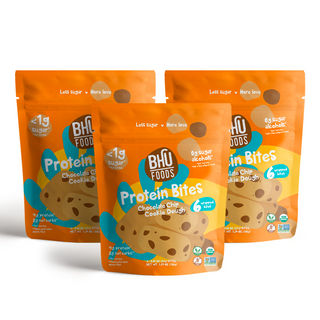
What to Expect if You Start the Keto Diet
The keto diet is known for its weight loss and blood sugar regulation benefits—which is especially great for diabetics in particular—but it definitely isn’t automatically smooth sailing when you first begin. You might notice some obstacles, which can make it tempting to stop and resume your regular diet instead.
The transition period can definitely be a bit rocky, so that’s why it’s smart to prepare yourself for common keto side effects when starting a low-carb diet, as well as the best solutions and handy helpers to make it easier on both your body and mindset.
And it’s worth it to wait and ride it out, as the keto diet benefits outweigh the short-term effects. Give it about two weeks for your body and mind to adjust to the fat-burning mechanism of the keto diet and the lower daily carbohydrate intake.
Plus, many keto approved foods are delicious, so expanding your snack foods repertoire and experimenting with various low-carb foods and meals can also be just as enjoyable as it is effective in losing and maintaining weight loss as well as feeling healthier and more energized long-term. Here’s what to expect when first going keto, plus tips for transitioning.
You Might Be Lethargic at First
While you’ll likely gain energy once the transition period is over, you may notice a decrease in energy and more fatigue when first beginning the keto diet due to a lack of steady and sufficient carbohydrate intake—the amount that your body has been used to. You will adjust to the lower number of grams per day though, and then you’ll start to use fat for fuel, as opposed to glucose (a.k.a. carbohydrate as the source).
To combat the fatigue, take an electrolyte booster, which you can find in supplement form or in a variety of keto approved foods, like plain unsweetened peanut butter, olives and olive oil, or plain unsweetened cottage cheese. And make sure to stick with a normal sleep schedule, as well as monitor the total number of calories consumed per day—don’t skimp and risk malnutrition, as your body does need enough calories for energy!
You’re at Risk for Greater Dehydration
It’s common to be thirstier than normal when you’re keto, especially if you’re just starting the keto diet too. When your body burns fat and switches its primary fuel source from glucose (carbs) to fat, you’ll find a depletion of electrolytes as the number of ketones increases in the body. Plus, you may lose more water weight upon just starting the keto diet, and that means there is more water loss.
Lack of fluids will make you thirsty, so it’s important to drink enough water and get in those fluids when keto—especially fluids containing electrolytes, such as water with an electrolyte powder that’s keto-friendly and low in sugar and carbs.
Coconut water could be another option, as long as it’s keto approved and unsweetened, but be sure to check labels. And of course, eating high-water content foods and electrolytes works too—these include zucchini, cucumbers and other green veggies, as well as olives and pickles, for example.
You May Have Cravings for Sugar and Carbs
Over time cravings will decrease, as you adjust to the low-carb keto diet and start to enjoy and consume more regularly keto approved meals and snacks. At first though, you might have more cravings for high-carb foods, like pasta and pizza, as well as sweets. Your best option is to keep some sweet keto snacks and desserts at home.
You don’t want to eat too many desserts each day though—there are still calories in them and you want to keep your daily calorie count in check for optimal weight loss and sufficient macro- and micro-nutrient intake. Integrate them as you would with any sweet. Save them for dessert or a pre-workout treat that has some extra bit of carbs or sugar as well as some protein and fiber to keep you full and energized as you exercise.
Options include cookies, cookie dough and bites, among other keto goodies. And grab a protein bar that tastes like dessert but actually has ample protein for a post-workout recovery snack.

Working Out Could be Extra Challenging
Don’t be too hard on yourself if you’re feeling too weak and tired to make it to the gym as you transition to the keto lifestyle. You’re going to feel weaker, less energized and more fatigued, and you may even have muscle cramps as you lose electrolytes and fluids and must figure out how best to replenish those lost stores.
As a result, exercising, especially with the full strength, stamina and speed you’re used to, will likely be a struggle—cut yourself some slack and try lower-impact workouts or just keep your body moving to avoid a sedentary lifestyle. Think: walking outside, riding your bike to work or through the park, and trying a yoga flow and stretching workout instead. Once adjusted you’ll be able to resume high intensity workouts or whatever activity you enjoy doing and had been doing prior.
Plus, you can do keto cycling around your workouts on the days you exercise for more carbohydrate-focused or an increased intake as fuel for both pre- and post-workout—without falling out of ketosis. It may be helpful to chat with a dietitian and trainer about keto cycling if you’re interested in giving it a shot, especially if you do lead an active lifestyle or are an athlete.
You’ll Drop Weight Fast—But It’s Mostly Water Weight
Upon first starting the keto diet, you may notice a dramatic drop in weight when weighing yourself during the two week period. However, take note that you’re not losing fat, but instead it’s mostly water weight falling off. Of course, that’s still great! You’re progressing, where the keto diet is most effective for you; yet, you’ll need to continue with it in order to get the fat to budge.
Once water weight is gone and you’re regularly in ketosis, you’ll burn fat for fuel—and that’s where the subsequent pounds lost will come from fat on the body, where you’ll see yourself leaning out and shedding fat.














































